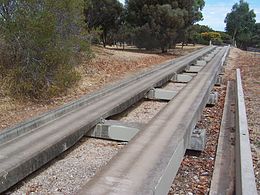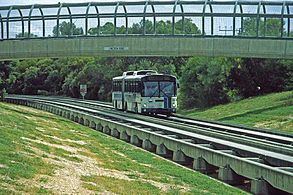Adelaide trolleybus
The Adelaide O-Bahn is a track bus system in Adelaide in southern Australia , which connects the city center with the northeastern suburbs. The buses run on a track-guided route on a twelve-kilometer route; then they can leave the lane and serve various destinations.
history
Planning and construction
At the beginning of the 1980s, Adelaide was looking for a way to make local public transport more independent of individual traffic, as delays often occurred at peak times. Initially, a light rail system was planned, but studies have shown that only 13 percent of passengers would be able to reach their destination without having to change trains, while this figure would be 80 percent with a lane bus system in which the buses could continue on their way after the end of the track-guided section. First, a 1.5-kilometer test track was built from October 1981 to November 1982, followed by two six-kilometer sections for passenger service by 1988. The road was designed by Ed. Züblin AG developed. The Adelaide O-Bahn is based on the track bus system from Essen in North Rhine-Westphalia , but has been adapted to local conditions. For example, the maximum speed limit is higher because the distances between stops in Adelaide are three to six kilometers. In addition, the route was elevated to reduce pollution. The width of the two-lane driveway is 6.2 meters and is therefore in the order of magnitude of tram routes.
business
Originally, buses of the type Mercedes-Benz O 305 were used, which were later replaced by vehicles from MAN and Scania . Around 1990 two "transit" lines were set up that run through the O-Bahn without using the stops there. In the 1990s, 22,000 passengers were counted on the O-Bahn route on an average weekday; 4,500 of them during rush hour between 8:00 and 9:00 a.m. At peak times, the route was used by up to 67 buses every hour; in off- peak hours a car ran every three and five minutes.
The maximum permissible speed on the O-Bahn was reduced from 100 to 85 km / h in 2012. This measure should extend the travel time over the entire route by a maximum of 20 seconds. This is to prevent accidents or reduce their extent. However, critics see the measure as a reaction to the age of the driveway built in the 1980s.
Today the Adelaide O-Bahn is used by around eight million passengers annually. Plans are underway to expand the line, and an underground extension is also being considered.
gallery
Web links
Individual evidence
- ↑ a b c Hans Pohl: The omnibus history of Daimler-Benz AG and its predecessor companies 1895-1995 . Delius Klasing, Vaihingen / Enz 2000, ISBN 3-7688-1243-X , p. 143.
- ^ O-Bahn Busway at baulderstone.com.au , accessed June 23, 2014.
- ^ A b c Government of South Australia - Department of Planning, Transport and Infrastructure: O-Bahn City Access project on infrastructure.sa.gov.au , accessed on June 23, 2014.
- ↑ a b c Passenger Transport Board: Adelaide's O-Bahn Busway on globaltelematics.com , accessed July 27, 2014.
- ↑ a b Liam Mannix: Is the O-Bahn track nearing end of life? at indaily.com.au , October 28, 2013, accessed June 23, 2014.
- ↑ Chris Brunner: Underground O-Bahn for Adelaide under transport plan ( Memento of the original from June 21, 2015 in the Internet Archive ) Info: The archive link was inserted automatically and has not yet been checked. Please check the original and archive link according to the instructions and then remove this notice. on au.news.yahoo.com (English) , October 21, 2013, accessed June 23, 2014.
- ↑ O-Bahn bus tunnel promised for Adelaide if Labor wins March 15 SA election on abc.net.au (English) , February 13, 2014, accessed on June 23, 2014.






